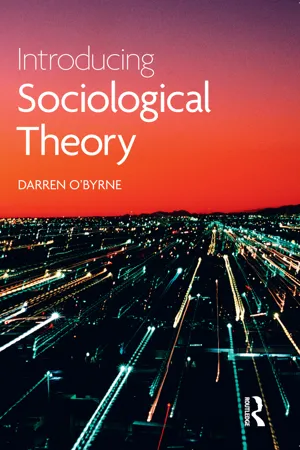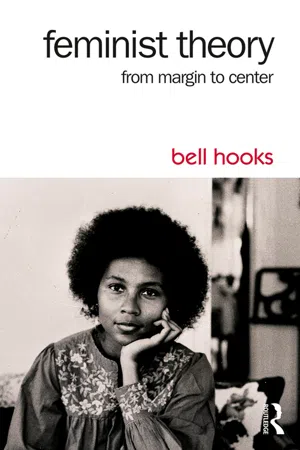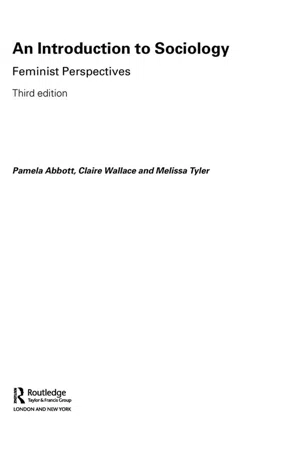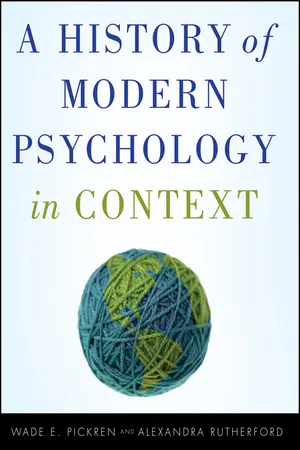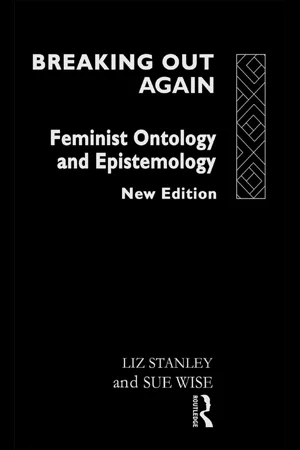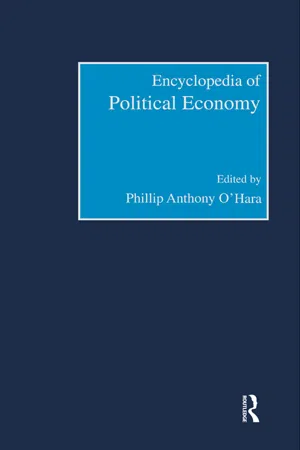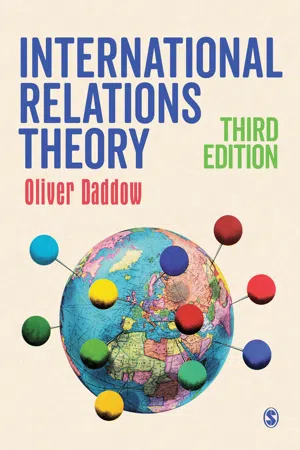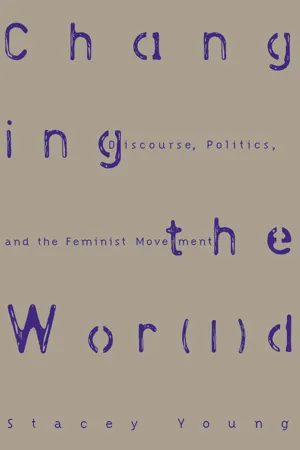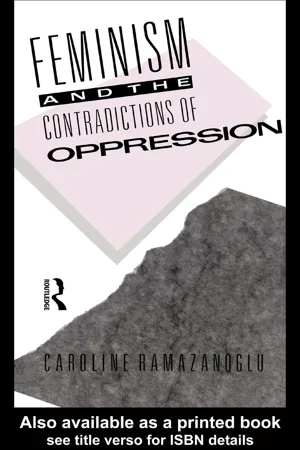Social Sciences
Feminism
Feminism is a social and political movement that advocates for the equality of the sexes and the rights of women. It seeks to challenge and dismantle gender-based discrimination, stereotypes, and power imbalances in society. Feminism encompasses a wide range of perspectives and approaches, all aimed at promoting gender equality and addressing issues such as reproductive rights, workplace discrimination, and gender-based violence.
Written by Perlego with AI-assistance
Related key terms
11 Key excerpts on "Feminism"
- eBook - ePub
- Darren O'Byrne(Author)
- 2013(Publication Date)
- Routledge(Publisher)
FeminismIn this chapter we will be:- introducing the key ideas underpinning feminist sociological theory, i.e. a sociological theory that highlights inequalities, and power relations, between men and power;
- comparing different types of feminist theory;
- distinguishing between ‘sex’ and ‘gender’;
- discussing the core term in feminist sociology, which is patriarchy, and looking at how the perceived dominance of men over women is reproduced through social institutions such as the family, education and religion;
- looking at how some feminists have drawn attention to women’s experiences and values which have been ignored by male-dominated disciplines such as sociology.
Types of feminist theory
Feminism is one of those perspectives in social theory that is broadly generic across a range of disciplines – feminist contributions to international relations, criminology, political science, socio-legal studies, development studies, social anthropology, social policy, social psychology as well as sociology, have made similar criticisms of their own disciplines as well as of society itself. Across the fields and disciplines, feminists draw attention to the exclusion of women – women’s voices, women’s experiences – from the academic and political debates. They seek to show that, in so far as these debates are dominated by male voices, they necessarily promote male interests and marginalise or subordinate the interests of women.However, while this provides a shared platform for feminist theory, feminists are often divided on the necessary direction that theory should take to overcome these problems. As we shall see, Feminism, like Marxism in the previous chapter, is an incredibly diverse collection of approaches united under a loose umbrella, a general condemnation of the gender imbalance in society. To understand Feminism as a theory in sociology, we first have to appreciate that it is indeed an umbrella, covering a diversity of ideas and a fair amount of internal disagreement. The various ‘types’ of Feminism are well covered in text books, and while their respective approaches to the concept of male power are also well documented, perhaps what isn’t clear is precisely how these different variants are distinct from one another. A straightforward way of approaching this problem is to compare how the different versions of feminist theory view the relationship between - eBook - ePub
Feminist Theory
From Margin to Center
- bell hooks(Author)
- 2014(Publication Date)
- Routledge(Publisher)
Since bourgeois white women had defined Feminism in such a way as to make it appear that it had no real significance for black women, they could then conclude that black women need not contribute to developing theory. We were to provide the colorful life stories to document and validate the prevailing set of theoretical assumptions. (An interesting discussion of black women’s responses to feminist movement may be found in the essay “Challenging Imperial Feminism” by Valerie Amos and Pratibha Parmar.) Focus on social equality with men as a definition of Feminism led to an emphasis on discrimination, male attitudes, and legalistic reforms. Feminism as a movement to end sexist oppression directs our attention to systems of domination and the interrelatedness of sex, race, and class oppression. Therefore, it compels us to centralize the experiences and the social predicaments of women who bear the brunt of sexist oppression as a way to understand the collective social status of women in the United States. Defining Feminism as a movement to end sexist oppression is crucial for the development of theory because it is a starting point indicating the direction of exploration and analysis.The foundation of future feminist struggle must be solidly based on a recognition of the need to eradicate the underlying cultural basis and causes of sexism and other forms of group oppression. Without challenging and changing these philosophical structures, no feminist reforms will have a long-range impact. Consequently, it is now necessary for advocates of Feminism to collectively acknowledge that our struggle cannot be defined as a movement to gain social equality with men, that terms like “liberal feminist” and “bourgeois feminist” represent contradictions that must be resolved so that Feminism will not be continually co-opted to serve the opportunistic ends of special-interest groups. - eBook - ePub
An Introduction to Sociology
Feminist Perspectives
- Pamela Abbott, Melissa Tyler, Claire Wallace(Authors)
- 2006(Publication Date)
- Routledge(Publisher)
There are a wide variety of feminist views regarding the relationship between Feminism and malestream social, political and cultural theory. As Chris Beasley puts it:(Beasley, 1999, pp. 14–15)They range from a perspective which considers Feminism and mainstream theory to be compatible and quite similar, to an approach which sees Feminism as breaking down the very categories that are used in traditional theory. . . . However, the critique offered by Feminism – that is, the viewpoint that there is something inadequate and unjust about traditional theory – is more straightforwardly encapsulated than what Feminism offers as the alternative. What Feminism actually offers, beyond its initial criticism of existing thought, is very diverse. And so the question remains, ‘what is Feminism?’Feminism, like sociology, is a theory – a world view. However, it is not a unified one; feminists do not agree on the ways in which we can explain women’s subordination or on how women can be emancipated, or even on what constitutes oppression. As Alison Jagger (1983, p. 353) has put it, ‘there are many ways of being a feminist’. Indeed, by the close of the twentieth century, Western Feminism could no longer be divided simply into the general categories of liberal, radical and Marxist traditions – if indeed, it ever could. ‘Many other approaches, drawing upon an increasingly eclectic and sometimes rather inaccessible range of social and political theories, became a feature of academic Feminism at least’ (Beasley, 1999, p. 65).Hence, there are now a large number of feminist perspectives, and feminist sociology draws on a wide range of disciplines, so that any attempt to classify feminist theories is fraught with problems. Also, the impact of postmodern thought on sociology means that theoretical perspectives that might previously have been regarded as incompatible (Marxist and radical Feminisms, for instance) have in some ways begun to cross-fertilise. Similarly, the assumption that sociologists adhered to one particular theoretical perspective and so rejected all others out of hand has also been largely disregarded. Any system of classification is therefore arbitrary and incomplete. It is arbitrary because we force ideas into a category, one with which feminist theorists themselves may not identify, and describe a given position as if it were totally unified rather than representing a range of ideas that show some broad agreement, or that share certain concepts and influences in common. It is incomplete because our categories do not incorporate all Feminisms (psychoanalytic and existentialist Feminisms, for instance, have not been included here as, to date, their impact on sociological thought has been relatively limited). - eBook - ePub
- Wade Pickren, Alexandra Rutherford(Authors)
- 2010(Publication Date)
- Wiley(Publisher)
Second-wave Feminism has been justifiably criticized as exclusively representing the concerns and outlooks of women at the center—generally heterosexual, White, middle-class women—and ignoring the complex intersections of gender with race, ethnicity, sexual orientation, socioeconomic status, and other important identity categories. Psychology of women and feminist psychology have also been critiqued for failing to consider and theorize intersectionality —the interdependent relations among categories such as gender, race, and class—adequately and for representing the experiences and concerns of middle-class heterosexual White women exclusively. Although feminist psychologists are responding to these critiques, changes to mainstream psychological theory and method are slow in coming. This is partly due to the persistence, at least in the American context, of the gender-differences paradigm, which often excludes consideration of other dimensions of difference and the ways they may come together in unique constellations to affect women’s experiences. It is also due to the continued methodological conservatism of scientific Psychology. Intersectionality is a complex phenomenon demanding a range of methodological approaches. Psychology, as a discipline, has been reluctant to deviate from its natural science persona for fear of being cast as a soft science or relegated to the humanities. As a result, some phenomena that resist simple operationalization or reductionism have received less attention. As feminist psychologist Stephanie Shields (whose historical scholarship we mentioned earlier) has written, “Despite recognition of the significance of intersectionality, empirical application of this perspective has lagged behind, particularly in psychology” (2008, p - eBook - ePub
Breaking Out Again
Feminist Ontology and Epistemology
- Liz Stanley, Sue Wise(Authors)
- 2002(Publication Date)
- Routledge(Publisher)
Feminism and the social sciencesFeminism demonstrates, without any possibility of doubt, that the social sciences are sexist, biased, and rotten with patriarchal values. However, feminist social science can be truly scientific in its approach. Having eradicated sexism, we can see and research the world as it truly is. Feminism encapsulates a distinctive value position, but these are truly human values, not just those of a ‘women’s perspective’. And so these values should be those of all people.Our response to this view is ‘well, perhaps’. We feel that such criticisms of the social sciences are justified—as far as they go. But we also argue that the basic assumptions about social reality which are present within sexist social science are also present within most feminist social science. These criticisms, we say, are not far-reaching enough, not radical enough, not feminist enough.A necessary starting point in examining some of these ideas is what has been called the ‘female critique’ of the social sciences. Work produced within this critique has been pioneering in what it has said and what it has attempted to do. And because it has been pioneering in this way we, and all other feminist researchers and scholars, are deeply indebted to it. But although we see this work as a necessary starting point, we don’t think it should be treated as tablets of stone brought down from the feminist mountain top. We pick out various pieces of work as ‘standing for’ certain ideas we want to explore within this critique. In doing so we’ve not attempted to examine whole bodies of work but particular themes and ideas which seem important and interesting.KEY THEMES IN THE FEMINIST CRITIQUE
‘The female critique’
The most simple and in many ways the most powerful criticism made of theory and practice within the social sciences is that, by and large, they omit or distort the experience of women. Perhaps the most fully developed of such criticisms is made in relation to sociology by Ann Oakley (1974), who argues that sociology is sexist because it is solely concerned with the activities and interests of men. The subject-areas sociology is concerned with are artificial constructs which distort human experience. One consequence of this is that women’s ‘social presence’ within these areas of life is high although their ‘sociological visibility’ is low. In other words, although women are frequently massively present within whatever is studied, we but rarely appear in the end products of this. This may be because women are simply not ‘seen’ by researchers, are ignored by them or else our experiences are distorted by them. Oakley goes on to examine some possible explanations for sexism in sociology. She argues that there are three main explanations. The first of these lies in the origins of sociology, more specifically in the sexist interests and personalities of its ‘founding fathers’. Second, it is a ‘male profession’, because a preponderance of the people within it are men; it is therefore bound to reflect their interests and views of reality. Oakley feels that the third, and the main, reason for sexism within sociology concerns the ‘ideology of gender’ which leads people to construe the world in sexually stereotyped ways. Such a world view not only focuses attention on some areas of social reality (those which concern men), it also focuses attention away - eBook - ePub
Theories of International Relations
Contending Approaches to World Politics
- Stephanie Lawson(Author)
- 2015(Publication Date)
- Polity(Publisher)
8Feminism and Gender TheoryBoth Feminism and gender theory are concerned with how biological sex – which is conventionally understood as given by ‘nature’ – and the categories of masculine and feminine – which are socially constructed – are implicated in the dynamics of power. In this chapter we first consider the rise of Feminism as a body of theory concerned with the role and status of women vis-à-vis men and with the various Feminisms that have emerged. This pluralization indicates that Feminism is no homogeneous category but rather a very diverse intellectual enterprise with conflicting strands, some of which intersect with other theories and ideologies discussed in this book. Gender theory is linked to the rise of Feminism but is more expansive in devoting equal attention to problems with the construction of masculinity, as well as hierarchies within these categories. For social and political theory generally, gendered roles, gendered hierarchies, and the very notion of a simple masculine/feminine binary gender divide are of particular importance in the analysis of power.This chapter looks specifically at the emergence of feminist IR as well as at gender issues in global political economy and the state of political representation, both of which indicate that gender parity in the political and economic spheres is still very far from being realized. Finally, we consider the gendered nature of war and the military along with the very problematic issue of sexual violence in the broader context of political violence. This sheds light on an aspect of power politics that has long been ignored in traditional IR theory.The discussion further illuminates several themes of the book. First, it will be seen that the various versions of Feminism and gender theory are strongly normative in their critique of the institution of patriarchy and conventional models of femininity and masculinity. Second, they engage with issues concerning what is ‘natural’ or otherwise in terms of gender and provide some rather different perspectives on the ‘naturalization of power’. And, third, they challenge conventional understandings of reality through exposing the subjective, interest-laden dimensions of gendered constructions of legitimate power and authority and the implications for politics at various levels, from the local through to the global sphere. - eBook - ePub
Encyclopedia of Political Economy
2-volume set
- Phillip O'Hara(Author)
- 1999(Publication Date)
- Routledge(Publisher)
Feminism and Science, Bloomington, IN: Indiana University Press.DRUCILLA K.BARKER feminist political economy: history and natureFeminist political economy is a counter-disciplinary approach to understanding the way in which GENDER has been culturally constructed and intertwined with the processes of CLASS formation, race and other forms of social identity to support women’s disadvantaged social position. The history and nature of feminist political economy is complex because Feminism is not a monolithic mode of analysis. Feminism is compatible with a variety of philosophical perspectives reflecting the many positions from which PATRIARCHY has been challenged.During the nineteenth and early twentieth centuries, the traditions of liberalism, socialism and institutionalism informed feminist thinking. Each perspective offered a partial description and explanation of women’s disadvantaged social position and strategy for change. Gender as an analytic category dominates early feminist writings. A recognition of the interlocking categories of race, class, sexuality and so on is less evident.Liberal feminist perspectivesThe liberal perspective holds a concept of human nature that locates individual uniqueness in the capacity for rationality. Accordingly, women’s true capacity for reason and potential for autonomy and freedom is limited by laws and customs which exclude them from the public sphere. Women’s oppression is understood as a cultural lag. Modern society with its technology, democracy and material wealth provides the preconditions for women’s liberation. Justice, therefore, requires the elimination of gender discrimination, and strategies for change emphasize equal opportunity and individual action—in particular, education and political participation. The goal is to reform CAPITALISM through rational persuasion rather than activism.The liberal perspective is often traced to John Stuart Mill’s The Subjection of Women - eBook - ePub
- Shirley Chew, David Richards(Authors)
- 2013(Publication Date)
- Wiley-Blackwell(Publisher)
Such notions of commonality were themselves based on ideas about similar patterns of socialization among women, on their childbearing and nurturing qualities, and on how these might inspire common ways of perceiving, knowing, and conceptualizing experience. Feminism’s political ideology derived its unity and organizational strength from this understanding of women’s experience. It theorized its notion of sexual politics from the premise that the differentiation of status and power between male and female was the root cause of a patriarchal domination of the world, and feminist discourse should therefore focus primarily on confronting and changing this fundamental inequality in gender relations. Race, class, and sexual orientation would be automatically addressed, it was felt, in the all-embracing politics of gender.In the 1960s and 1970s, feminist discourse focused on social and personal power relations between the sexes, making these the central political agenda for women globally. Sexual politics became a specific branch of knowledge with a particular set of assumptions and interpretive strategies. Making gender a category of analysis in all areas of knowledge helped feminists to uncover power structures, biases, and exclusions in the construction of knowledge and to rethink almost all the disciplinary paradigms. It was Feminism’s revisions of existing knowledge and its theorizing of gender that moved the notion of gender itself beyond biological difference into the arena of culture, history, politics and religion. The idea that it was societies and cultures that constituted meanings around sexual difference seemed a logical way of understanding and probing hierarchical power relations in politics and culture. It helped feminists in all the disciplines to probe the historical roots of assumptions about women and interrogate their meanings. Feminist discourse located constructs like masculinity and femininity in day-to-day cultural, social, and political interaction and sought new ways of understanding and rethinking them.The questions feminists faced, both in the global liberation movement, and in feminist critical studies, was how to give voice to the dissenting and submerged views and ideas of women and, at the same time, move beyond dissent and rupture to agency. In this early stage of theorization, the notion of agency, whether viewed as an individual or social issue, rested on how both men and women are constituted as subjects in discourse. The ability to challenge existing discourses about women and mobilize them in new ways was seen as one of the most forceful acts of agency in history, and feminist critical interrogations invested a lot in identifying and rethinking discourses built around the silencing, marginalization, and oppression of women. - eBook - ePub
- Oliver Daddow(Author)
- 2017(Publication Date)
- SAGE Publications Ltd(Publisher)
11 FeminismKey terms
- Gender
- Masculine/feminine
- Patriarchy
- Rationality
- Security
- Sovereignty
[F]eminism defies premature attempts at closure. There are the political-theoretical versions: radical, Marxist, liberal, psychoanalytic Feminisms and there are more abstract conceptual visions or versions including a feminist variant on structuralism, world systems theory, feminist standpoint theory … as well as feminist post-modern theories. (Elshtain 1995: 342–3)Feminist scholarship came to the discipline of IR in and around the 1980s and 1990s. As with other normative theories we have covered in the last few chapters in this book, it was not IR that produced feminist scholarship. Feminists, rather, came into conversation with IRT as part of a wider social and intellectual movement from the 1960s that has had – and continues to have – a major impact across politics, academia and society (Young 2016: 3). In IR, feminist scholars have added a vital new term to the language of IR: gender. This has gone hand in hand, in many but not all cases, with a thoroughgoing reassessment of the ways in which IR scholars try to make sense of their subject matter, including such disciplinary fundamentals as war, security and anarchy. Feminist scholarship can also be referred to as gender theory.Feminist scholars have therefore achieved two significant things in IRT. First, they have ‘added’ women where previously they were overlooked or invisible in the study of international affairs. But much more than this, second, they have reassessed definitions and re-thought methods of studying central IR concepts such as the state, security and sovereignty. As such, critical branches of Feminism share affinities with ‘thick’ constructivism and poststructuralism in that they seek to go beyond hackneyed ways of defining and studying IR to lay bare the power relations in ‘doing’ IR a certain way. Meanwhile, Postcolonial feminists accent the experiences of ‘non-Western’ females and other subjects left out, or marginalized by, European and North American accounts of global politics and history. This chapter will begin by introducing the concept of gender and move on to highlight the different varieties of feminist scholarship you might encounter on your course in IRT. - eBook - ePub
Changing the Wor(l)d
Discourse, Politics and the Feminist Movement
- Stacey Young(Author)
- 2014(Publication Date)
- Routledge(Publisher)
Gelb locates the source of these differences—and of what she sees as the differential impact of the two approaches—in the two countries' contrasting formal political structures. The United States is more open to influence from interest groups, while Great Britain is more corporatist, not as pluralist as the United States. The differences between the feminist movements in the two countries can be attributed, she argues, to the different opportunities that follow from those state structures.1. “Women”/The Subject-actor
In each of the women's movement studies, how the authors conceive of the category of "women" sometimes emerges in explicit statements regarding the diversity of women's experiences and concerns. More often, their views about who women are emerge indirectly in the issues they identify as central to Feminism. For example, authors who identify, respectively, the existence of private all-male business clubs, forced sterilization, and lesbian mothers' custody battles as central to Feminism probably imagine different—if overlapping—constituencies when they refer to "women" or "women's concerns." Thus, the studies' conceptualizations of domination are embedded in their discussions of who women are and what concerns them most.Ferree and Hess
In their introductions to both editions of their book, Ferree and Hess write, "Oversimplification characterizes much of what has been written about the contemporary women's movement, both in the professional and popular press," and they maintain thatIt is, in fact, impossible to write of the organized feminist movement without placing it in the context of many diverse strands of feeling and action. In one sense, these underlying currents are "the movement," of which organized Feminism is only one highly visible element. This diversity is our central theme.14 - eBook - ePub
- Caroline Ramazanoglu(Author)
- 2012(Publication Date)
- Routledge(Publisher)
Regardless of the version of Feminism which is favoured, the point of developing feminist social theory is to use it to improve women’s lot. In this view, social theories are not developed simply as intellectual exercises. The kinds of theories that people draw on to explain the world they experience will affect their behaviour. Women who see the troubles of their lives as due to their own inadequacies as wives and mothers will not behave in the same ways as those who attribute their troubles to men, or to economic exploitation or to religious destiny. Any evaluation of Feminism, then, will need to pay attention to the links between theory and practice. The radical feminist slogan ‘the personal is political’ has also been taken up by marxist feminists, but does not sit easily with liberal assumptions. The liberal analysis of the relations between the sexes is less one of oppression than one of inequality, injustice, and discrimination which works to women’s disadvantage. Strategies to tackle inequality are in practice very different from strategies aimed at transforming power relations between men and women. When social analysis is translated into action, the contradictions inherent in the production of feminist knowledge become clear.Feminism is not, then, simply a political corrective for remedying the inadequacies of other theories. If Feminism is to be more generally politically effective, we need much more precision in feminist knowledge than the political conviction that it is superior to sexist knowledge, or the hope that it can ultimately be validated politically, through practice and struggle. As Midgley and Hughes have argued (1983:219), ‘Feminism was never only an eccentric fad, and it is not so today. It is rooted in serious troubles affecting the lives of large numbers of ordinary people.’ A great deal of personal suffering is involved if we get our applied social theory wrong.It is both a strength and a weakness of Feminism that its analyses of women’s oppression create practical strategies for changing this oppression. Feminism’s weakness lies in the philosophical difficulties of producing valid feminist knowledge which have diversified our knowledge of women’s oppression. Diverse conceptions of oppression lead to diverse strategies for liberation. Feminism’s strength lies in new ways of thinking about the desirability of change which are opened up by questioning much that has previously been taken for granted in the relations between the sexes. It is this strength which is reviewed in chapter 4
Index pages curate the most relevant extracts from our library of academic textbooks. They’ve been created using an in-house natural language model (NLM), each adding context and meaning to key research topics.
